IP-Dip-Based SPR Structure for Refractive Index Sensing of Liquid Analytes
Abstract
1. Introduction
2. Design and Fabrication of SPR Structure
3. Experimental
4. Results
5. Conclusions
Author Contributions
Funding
Institutional Review Board Statement
Informed Consent Statement
Data Availability Statement
Conflicts of Interest
References
- Novak, J.; Elias, P.; Hasenohrl, S.; Laurencikova, A.; Kovac, J., Jr.; Urbancova, P.; Pudis, D. Twinned nanoparticle structures for surface enhanced Raman scattering. Appl. Surf. Sci. 2020, 528, 146548. [Google Scholar] [CrossRef]
- Bhatnagar, K.; Pathak, A.; Menke, D.; Cornish, P.V.; Gangopadhyay, K.; Korampally, V.; Gangopadhyay, S. Fluorescence enhancement from nano-gap embedded plasmonic gratings b a novel fabrication technique with HD-DVD. Nanotechnology 2012, 23, 495201. [Google Scholar] [CrossRef]
- Gandhi, M.S.A.; Chu, S.; Senthilnathan, K.; Babu, P.R.; Nakkeeran, K.; Li, Q. Recent advances in plasmonic sensor-based fiber optic probes for biological applications. Appl. Sci. 2019, 9, 949. [Google Scholar] [CrossRef]
- Wang, D.S.; Fan, S.K. Microfluidic surface plasmon resonance sensors: From principles to point-of-care applications. Sensors 2016, 16, 1175. [Google Scholar] [CrossRef]
- Bauch, M.; Toma, K.; Toma, M.; Zhang, Q.; Dostalek, J. Plasmon-enhanced fluorescence biosensors: A review. Plasmonics 2014, 9, 781–799. [Google Scholar] [CrossRef] [PubMed]
- Wang, J.; Lin, W.; Cao, E.; Xu, X.; Liang, W.; Zhang, X. Surface plasmon resonance sensors on Raman and fluorescence spectroscopy. Sensors 2017, 17, 2719. [Google Scholar] [CrossRef] [PubMed]
- Fang, N.; Lee, H.; Sun, C.; Zhang, X. Sub-diffraction-limited optical imaging with a silver superlens. Science 2005, 308, 534–538. [Google Scholar] [CrossRef] [PubMed]
- Prabowo, B.A.; Purwidyantri, A.; Liu, K.C. Surface plasmon resonance optical sensor: A review on light source technology. Biosensors 2018, 8, 80. [Google Scholar] [CrossRef]
- Homola, J. Surface plasmon resonance sensors for detection of chemical and biological species. Chem. Rev. 2008, 108, 462–493. [Google Scholar] [CrossRef]
- Zhang, L.; Miao, G.; Zhang, J.; Liu, L.; Gong, S.; Li, Y.; Cui, D.; Wei, Y.; Yu, D.; Qiu, X.; et al. Development of a surface plasmon resonance and fluorescence imaging system for biochemical sensing. Micromachines 2019, 10, 442. [Google Scholar] [CrossRef] [PubMed]
- Klantsataya, E.; Jia, P.; Ebendorff-Heidepriem, H.; Monro, T.M.; François, A. Plasmonic fiber optic refractometric sensors: From conventional architectures to recent design trends. Sensors 2017, 17, 12. [Google Scholar] [CrossRef]
- Hlubina, P.; Kadulova, M.; Ciprian, D.; Sobota, J. Reflection-based fibre-optic refractive index sensor using surface plasmon resonance. J. Eur. Opt. Soc. Rap. Publ. 2014, 9, 14033. [Google Scholar] [CrossRef]
- Arora, P.; Talker, E.; Mazurski, N.; Levy, U. Dispersion engineering with plasmonic nano structures for enhanced surface plasmon resonance sensing. Sci. Rep. 2018, 8, 9060. [Google Scholar] [CrossRef]
- Gupta, B.D.; Shrivastav, A.M.; Usha, S.P. Surface plasmon resonance-based fiber optic sensors utilizing molecular imprinting. Sensors 2016, 16, 1381. [Google Scholar] [CrossRef] [PubMed]
- Seo, M.; Lee, J.; Lee, M. Grating-coupled surface plasmon resonance on bulk stainless steel. Opt. Express 2017, 25, 26939–26949. [Google Scholar] [CrossRef] [PubMed]
- Xu, Y.; Bai, P.; Zhou, X.; Akimov, Y.; Png, C.E.; Ang, L.K.; Knoll, W.; Wu, L. Optical refractive index sensors with plasmonic and photonic structures: Promising and inconvenient truth. Adv. Opt. Mater. 2019, 7, 180143. [Google Scholar] [CrossRef]
- Couture, M.; Zhao, S.S.; Masson, J.F. Modern surface plasmon resonance for bioanalytics and biophysics. Phys. Chem. Chem. Phys. 2013, 15, 11190. [Google Scholar] [CrossRef] [PubMed]
- Rossi, S.; Gazzola, E.; Capaldo, P.; Borile, G.; Romanato, F. Grating-coupled surface plasmon resonance (GC-SPR) optimization for phase-interrofation biosensing in a microfluidic chamber. Sensors 2018, 18, 1621. [Google Scholar] [CrossRef] [PubMed]
- Ruffato, G.; Zacco, G.; Romanato, F. Innovative exploitation of grating-coupled surface plasmon resonance for sensing. In Plasmonics—Principles and Applications; Kim, K.Y., Ed.; Intech: Rijeka, Croatia, 2012; pp. 419–444. [Google Scholar]
- Indutnyi, I.; Ushenin, Y.; Hegemann, D.; Vandenbossche, M.; Myn’ko, V.; Lukaniuk, M.; Shepeliavyi, P.; Korchovyi, A.; Khrustosenko, R. Enhancing surface plasmon resonance detection using nanostructured AU chips. Nanoscale Res. Lett. 2016, 11, 535. [Google Scholar] [CrossRef]
- Ibrahim, J.; Masri, M.A.; Verrier, I.; Kampfe, T.; Veillas, C.; Celle, F.; Cioulachtjian, S.; Lefevre, F.; Jourlin, Y. Surface plasmon resonance based temperature sensors in liquid environment. Sensors 2019, 19, 3354. [Google Scholar] [CrossRef]
- Yu, C.C.; Ho, K.H.; Chen, H.L.; Chuang, S.Y.; Tseng, S.C.; Su, W.F. Using the nanoimprint-in-metal method to prepare corrugated metal structures for plasmonic biosensors through both surface plasmon resonance and index-matching effects. Biosens. Bioelectron. 2012, 33, 267–273. [Google Scholar] [CrossRef] [PubMed]
- Kumar, N.; Planken, P.; Adam, A.J.L. Emission of terahertz pulses from nanostructured metal surfaces. J. Phys. D Appl. Phys. 2014, 47, 374003. [Google Scholar]
- Guo, J.; Li, Z.; Guo, H. Near perfect light trapping in a 2D gold nanotrench grating at obliques angles of incidence and its application for sensing. Opt. Express 2016, 24, 17259–17271. [Google Scholar] [CrossRef]
- Iqbal, T.; Afsheen, S. One dimensional plasmonic grating: High sensitive biosensor. Plasmonics 2017, 12, 19–25. [Google Scholar] [CrossRef]
- Dou, X.; Phillips, B.M.; Chung, P.Y.; Jiang, P. High surface plasmon resonance sensitivity enabled by optical disks. Opt. Lett. 2012, 37, 3681–3683. [Google Scholar] [CrossRef] [PubMed]
- Lin, E.H.; Tsai, W.S.; Lee, K.L.; Lee, M.C.; Wei, P.K. Enhancing detection sensitivity of metallic nanostructures by resonant coupling mode and spectral integration analysis. Opt. Express 2014, 22, 19621–19632. [Google Scholar] [CrossRef]
- Choi, B.; Dou, X.; Fang, Y.; Phillips, B.M.; Jiang, P. Outstanding surface plasmon resonance performance enabled by templated oxide gratings. Phys. Chem. Chem. Phys. 2016, 18, 26078–26087. [Google Scholar] [CrossRef]
- Mohapatra, S.; Kumari, S.; Moirangthem, R.S. Fabrication of cost-effective polymer nanograting as a disposable plasmonic biosensor using nanoimprint lithogprahy. Mater. Res. Express 2017, 4, 076202. [Google Scholar] [CrossRef]
- Kuo, W.K.; Tongpakpanang, J.; Kuo, P.H.; Kuo, S.F. Implementation and phase detection of dielectric-grating-coupled surface plasmon resonance sensor for backside incident light. Opt. Express 2019, 27, 3867–3872. [Google Scholar] [CrossRef]
- Saito, Y.; Yamamoto, Y.; Kan, T.; Tsukagoshi, T.; Noda, K.; Shimoyama, I. Electrical detection SPR sensor with grating coupled backside illumination. Opt. Express 2019, 27, 17763–17770. [Google Scholar] [CrossRef]
- Singh, B.K.; Hillier, A.C. Surface plasmon resonance enhanced transmission of light through gold-coated diffraction gratings. Anal. Chem. 2008, 80, 3803–3810. [Google Scholar] [CrossRef] [PubMed][Green Version]
- Sun, Y.; Sun, S.; Wu, M.; Gao, S.; Cao, J. Refractive index sensing using the metal layer in DVD-R discs. RSC Adv. 2018, 8, 27423–27428. [Google Scholar] [CrossRef]
- Cao, J.; Sun, Y.; Kong, Y.; Qian, W. The Sensitivity of Grating-Based SPR Sensors with Wavelength Interrogation. Sensors 2019, 19, 405. [Google Scholar] [CrossRef] [PubMed]
- Nair, S.; Escobedo, C.; Sabat, R.G. Crossed surface relief gratings as nanoplasmonic biosensors. ACS Sens. 2017, 2, 379–385. [Google Scholar] [CrossRef] [PubMed]
- Borile, G.; Rossi, S.; Filippi, A.; Gazzola, E.; Capaldo, P.; Tregnago, C.; Pigazzi, M.; Romanato, F. Label-free, real-time on-chip sensing of living cells via grating-coupled surface plasmon resonance. Biophys. Chem. 2019, 254, 106262. [Google Scholar] [CrossRef] [PubMed]
- Kotlarek, D.; Vorobii, M.; Ogieglo, W.; Knoll, W.; Rodriguez-Emmenegger, C.; Dostalek, J. Compact Grating-Coupled Biosensor for the Analysis of Thrombin. ACS Sens. 2019, 4, 2109–2116. [Google Scholar] [CrossRef] [PubMed]
- Li, W.; Jiang, X.; Xue, J.; Zhou, Z.; Zhou, J. Antibody modified gold nano-mushroom arrays for rapid detection of alpha-fetoprotein. Biosens. Bioelectron. 2015, 68, 468–474. [Google Scholar] [CrossRef] [PubMed]
- Guner, H.; Ozgur, E.; Kokturk, G.; Celik, M.; Esen, E.; Topal, A.E.; Ayas, S.; Uludag, Y.; Elbuken, C.; Dana, A. A smartphone based surface plasmon resonance imaging (SPRi) platform for on-site biodetection. Sens. Actuators B Chem. 2017, 239, 571–577. [Google Scholar] [CrossRef]
- López-Muñoz, G.A.; Estevez, M.C.; Peláez-Gutierrez, E.C.; Homs-Corbera, A.; García-Hernandez, M.C.; Imbaud, J.I.; Lechuga, L.M. A label-free nanostructured plasmonic biosensor based on Blu-ray discs with integrated microfluidics for sensitive biodetection. Biosens. Bioelectron. 2017, 96, 260–267. [Google Scholar] [CrossRef]
- Kan, T.; Matsumoto, K.; Shimoyama, I. Tunable gold-coated polymer gratings for surface plasmon resonance coupling and scanning. J. Microchem. Microeng. 2010, 20, 085032. [Google Scholar] [CrossRef]
- Consales, M.; Ricciardi, A.; Crescitelli, A.; Esposito, E.; Cutolo, A.; Cusano, A. Lab-on-Fiber Technology: Toward Multifunctional Optical Nanoprobes. ACS Nano 2012, 6, 3163–3170. [Google Scholar] [CrossRef] [PubMed]
- Kumari, S.; Mohapatra, S.; Moirangthem, R.S. Development of flexible plasmonic plastic sensor using nanograting textured laminating film. Mater. Res. Express 2017, 4, 025008. [Google Scholar] [CrossRef]
- Dostalek, J.; Homola, J.; Miler, M. Rich information format surface plasmon resonance biosensor based on array of diffraction grating. Sens. Actuators B 2005, 107, 154–161. [Google Scholar] [CrossRef]
- Zhou, B.; Xiao, X.; Liu, T.; Gao, Y.; Huang, Y.; Wen, W. Real-time concentration monitoring in microfluidic system via plasmonic nanocrescent array. Biosens. Bioelectron. 2016, 77, 385–392. [Google Scholar] [CrossRef] [PubMed]
- Urbancova, P.; Pudis, D.; Kuzma, A.; Goraus, M.; Gaso, P.; Jandura, D. IP-Dip-based woodpile structure for VIS and NIR spectral range: Complex PBG analysis. Opt. Mater. Express 2019, 9, 4307–4317. [Google Scholar] [CrossRef]
- Urbancova, P.; Goraus, M.; Pudis, D.; Hlubina, P.; Kuzma, A.; Jandura, D.; Durisova, J.; Micek, P. 2D polymer/metal structures for surface plasmon resonance. Appl. Surf. Sci. 2020, 530, 147279. [Google Scholar] [CrossRef]
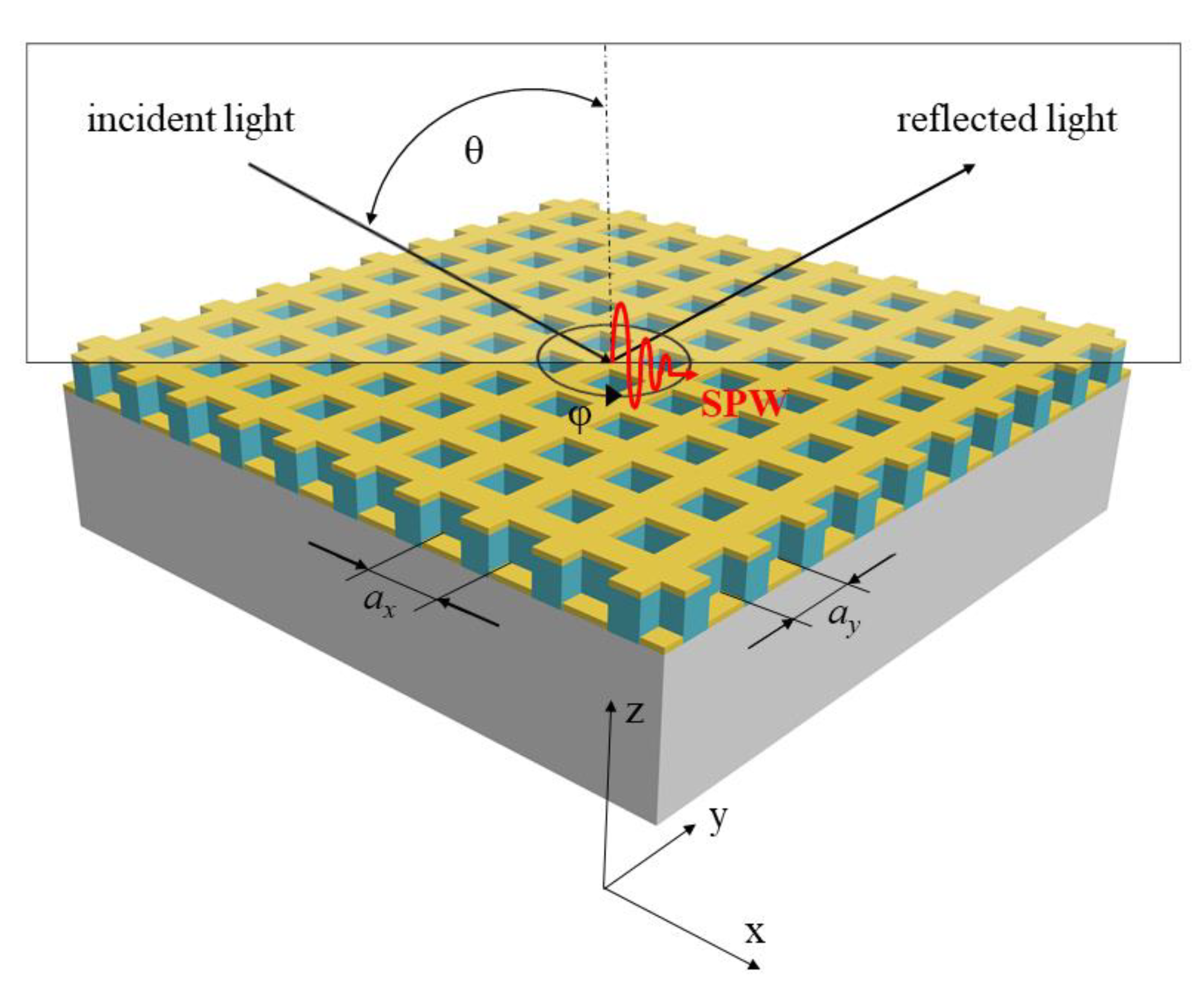
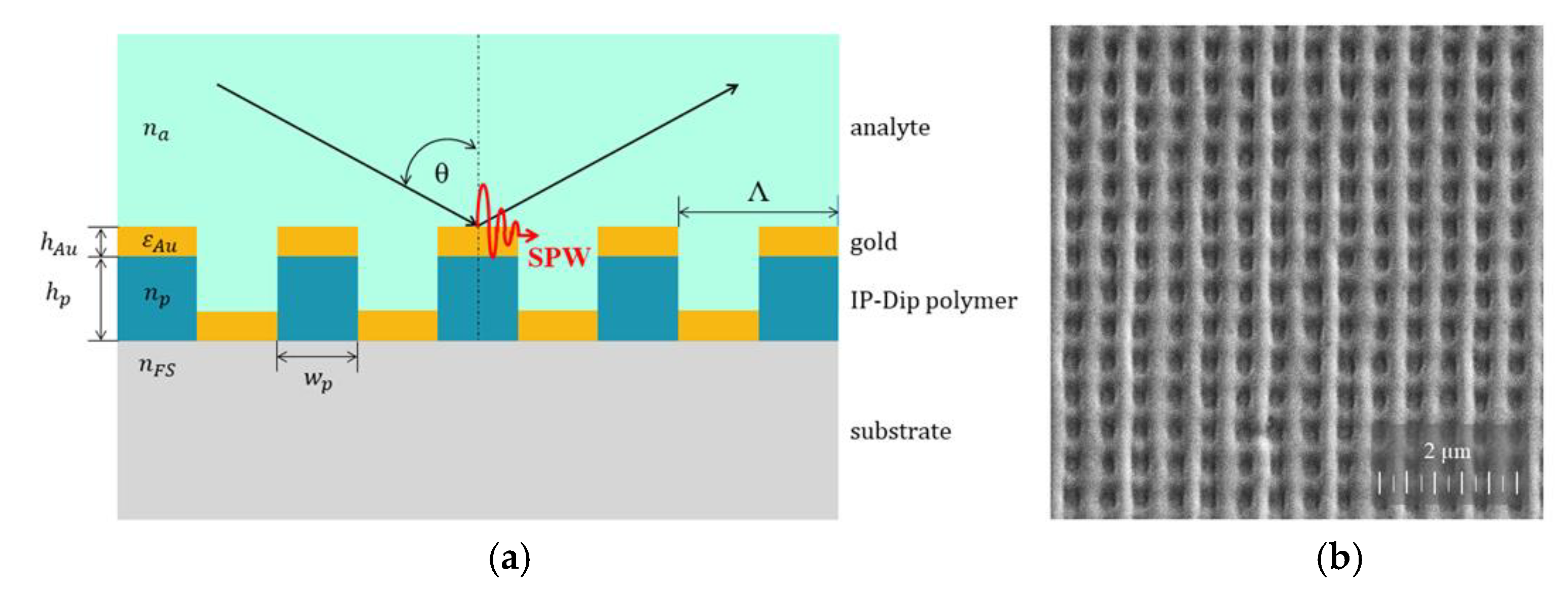
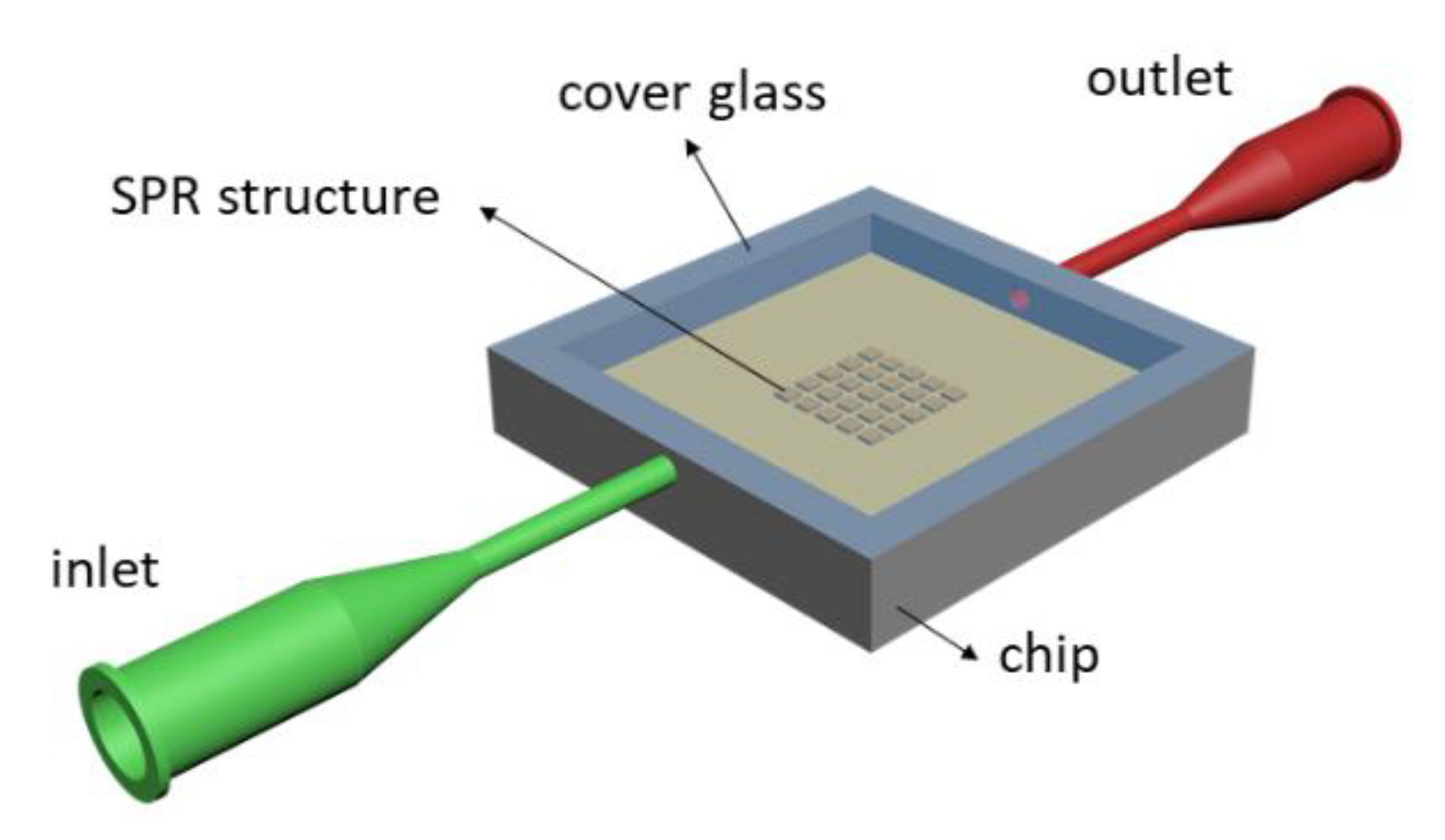
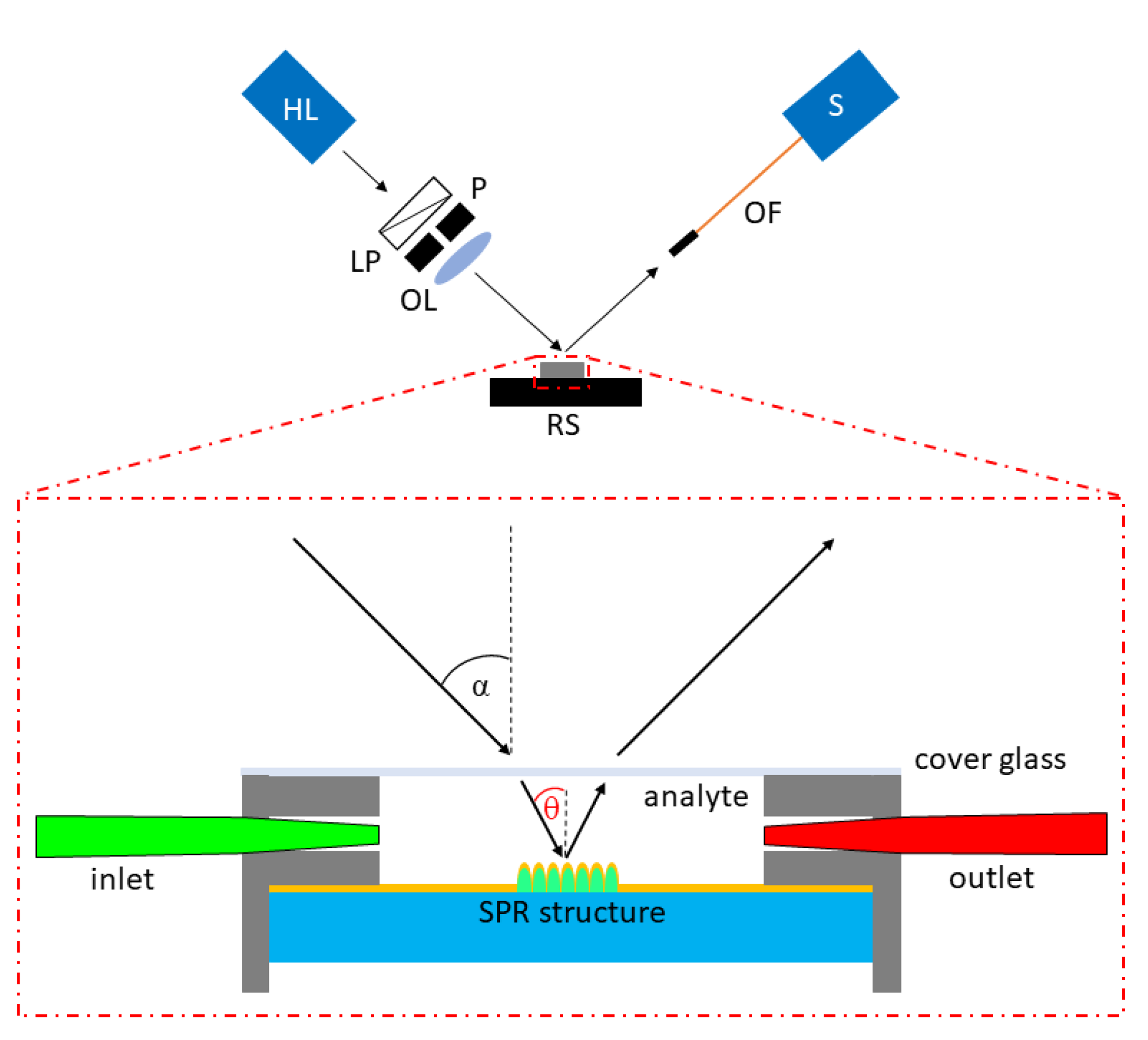
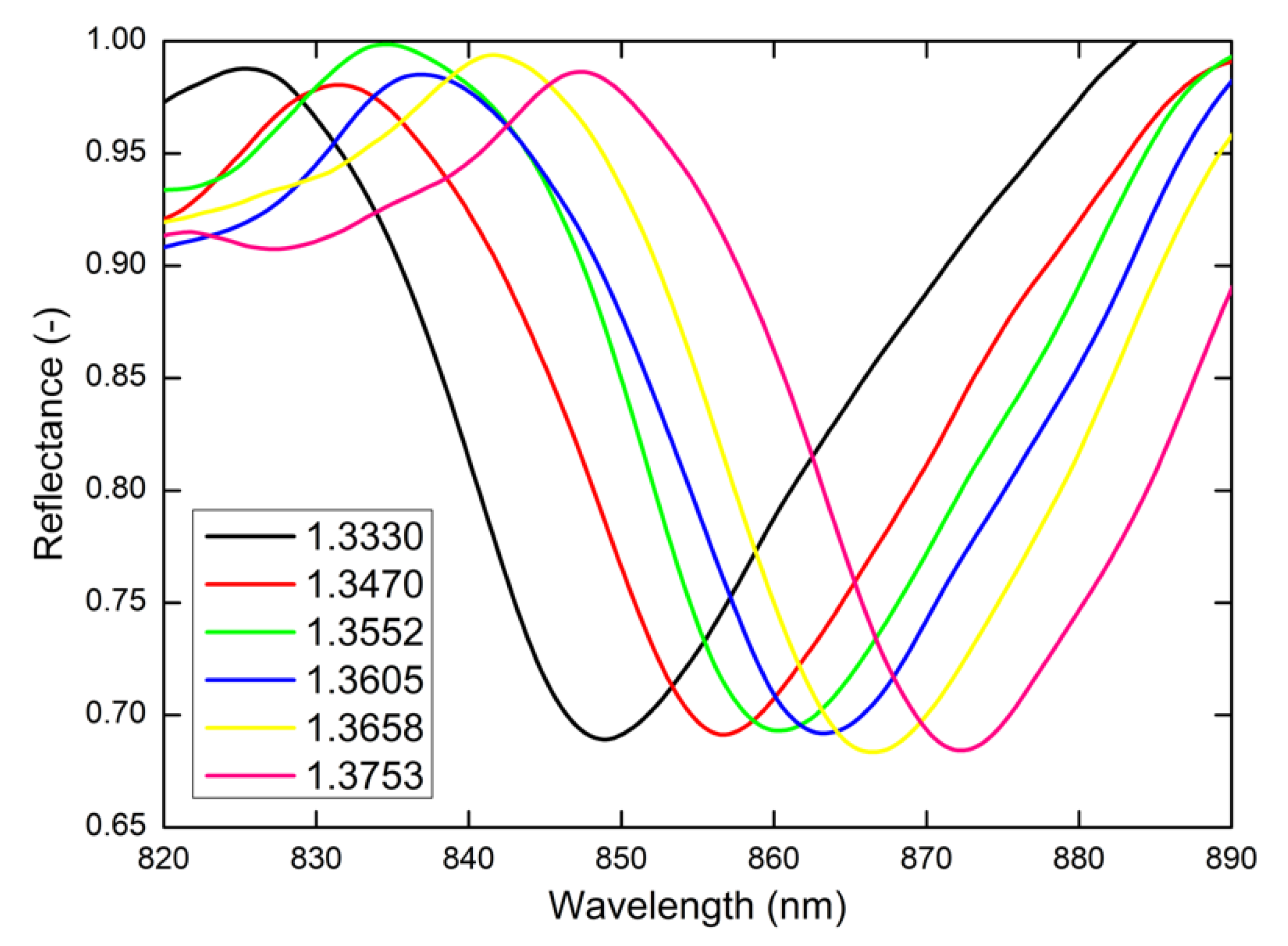
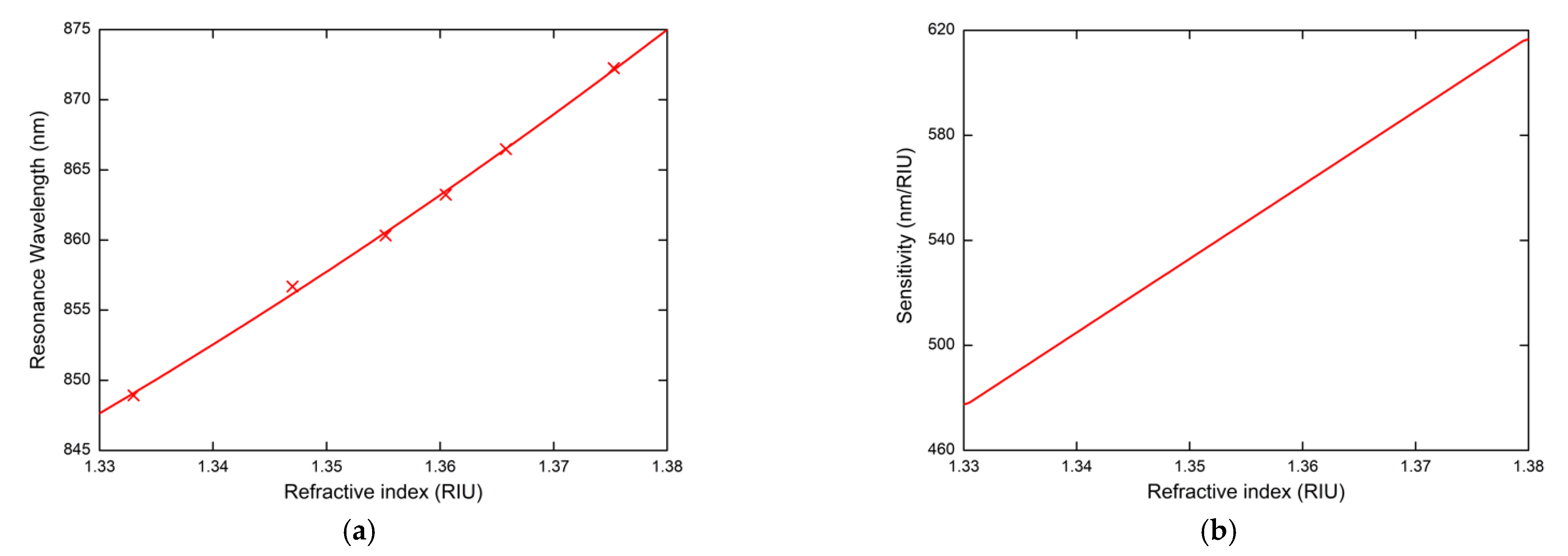
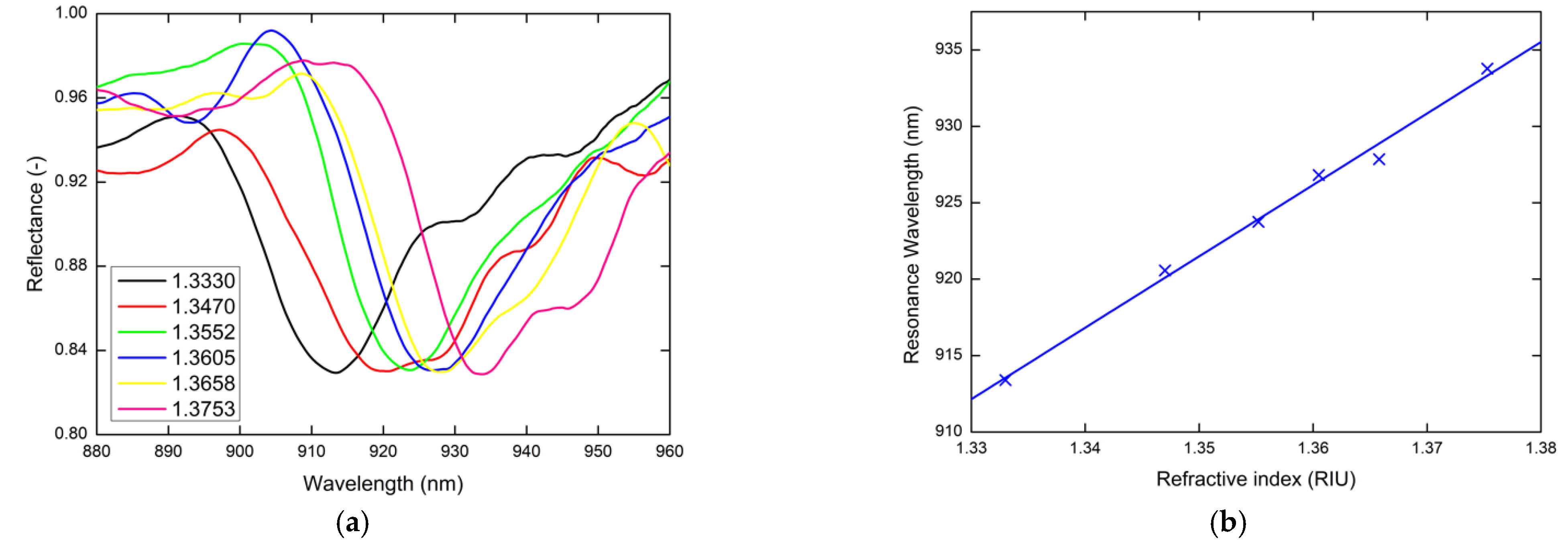
| Metal Layer | Fabrication Method | Measured Spectra | Grating | Λ (nm) | RI Range | Sn (nm/RIU) | FOM (RIU−1) | Ref. |
|---|---|---|---|---|---|---|---|---|
| Ag(80 nm)/Au(2 nm) bilayer | Peeling off + thermal vacuum evaporation | Reflectance | 1D | 320 | 1.335–1.365 | 356 | - | [39] |
| Au(100 nm) | Chemical removing + electron beam deposition | Reflectance | 1D | 320 | 1.334–1.3463 | 425 | 35 | [40] |
| Au(110 nm) | LIL + thermal evaporation | Reflectance | 2D | - | 1.333–1.413 | 465 | - | [38] |
| Au(50 nm) | FIB etching | Transmission | 1D | 525 | 1.33303–1.47399 | 524 | - | [25] |
| Au(500 nm) | e-beam lithography + plasma etching | Reflected | 2D | 400 | 1–1.37 | 544 | - | [24] |
| Au(40 nm) | DLW lithography + thermal evaporation | Reflected | 2D | 500 | 1.3330–1.3753 | 478–617 | 24 | This work |
| Au(60 nm) | Holographic exposure + sputter coating | Transmission | 2D | 550 | 1.330–1.357 | 648 | 14 | [35] |
| Au(100 nm) | Soft UV + plasma sputtering | Reflectance | 1D | 720 | 1.333–1.398 | 797 | - | [29] |
| Au(80 nm) | Nanoimprint + plasma sputtering | Reflectance | 1D | 730 | 1.333–1.398 | 800 ± 27 | - | [40] |
Publisher’s Note: MDPI stays neutral with regard to jurisdictional claims in published maps and institutional affiliations. |
© 2021 by the authors. Licensee MDPI, Basel, Switzerland. This article is an open access article distributed under the terms and conditions of the Creative Commons Attribution (CC BY) license (https://creativecommons.org/licenses/by/4.0/).
Share and Cite
Urbancova, P.; Pudis, D.; Goraus, M.; Kovac, J., Jr. IP-Dip-Based SPR Structure for Refractive Index Sensing of Liquid Analytes. Nanomaterials 2021, 11, 1163. https://doi.org/10.3390/nano11051163
Urbancova P, Pudis D, Goraus M, Kovac J Jr. IP-Dip-Based SPR Structure for Refractive Index Sensing of Liquid Analytes. Nanomaterials. 2021; 11(5):1163. https://doi.org/10.3390/nano11051163
Chicago/Turabian StyleUrbancova, Petra, Dusan Pudis, Matej Goraus, and Jaroslav Kovac, Jr. 2021. "IP-Dip-Based SPR Structure for Refractive Index Sensing of Liquid Analytes" Nanomaterials 11, no. 5: 1163. https://doi.org/10.3390/nano11051163
APA StyleUrbancova, P., Pudis, D., Goraus, M., & Kovac, J., Jr. (2021). IP-Dip-Based SPR Structure for Refractive Index Sensing of Liquid Analytes. Nanomaterials, 11(5), 1163. https://doi.org/10.3390/nano11051163







